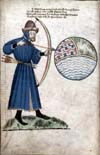| The King's Revenge |
International
John Gower
Society
|
The
King’s Revenge When King Alla wins his battle with the Scottish Picts in Trevet’s version of the story of Constance, he returns to England full of sorrow over the banishment of his wife, Constance, and their son, Maurice. The people yell insults at him as he passes until he finally reaches his castle. The scene runs some 520 words, which I provide in summary:
Gower renders the scene differently in some 425 words:
While the incidents in the two versions of the tale of Constance are similar, Gower makes important changes from his source in Trevet. He places Allee’s discovering of his mother’s deceit when Constance has already found her way to Rome, removes the public scorn on Allee’s return to the city following battles in Scotland, makes Allee discover or divine the identity of the treacherous person behind Constance’s disappearance, and makes the punishment Domilde receives more public and, given the circumstances, less grotesque. I believe that all of the changes Gower makes in this section of his tale are done to make the figure of Allee more compassionate and more human, and to establish a sense of community through more unanimous opinions and judgments on punishment for transgressions. The most obvious way Gower alters Trevet’s tale is by moving the scene of discovery and revenge later in his version. In Trevet, Constance did not travel to Rome until after we learned of Alla’s return and Domild’s brutal and grotesque death. After Trevet spent some narrative time and space discussing Constance’s means of getting to Rome through the help of Arsenius and his wife, Helen, we learned that while all of Constance’s activity was going on, Alla, under advice from Lucius and Olda, was preparing for a pilgrimage to Rome. In Gower we learn of this revenge plot after we know that Constance is already in Rome. Directly after we read how Constance is settled with Arcenne and his wife, Heleine, Gower shifts the narrative attention back to Allee, who uncovers the truth of his false letters and takes his anger and vengeance out on his mother. Moreover, the shift of this scene in the context of the narrative removes the possibility for a hostile re-entry into his city. In Gower’s version of the tale, Allee is not met by an angry mob that throws mud, rocks, or stones at him. He simply returns to his city and talks immediately with the bishop and his friend about his wife and son. Why does the shift of this part of the tale of Constance so greatly affect the progress of the story and character identification? In shifting this part of the narrative backward in the progression of the tale, Gower forces Allee to travel to Rome, in part to show how genuinely good a person Allee is. Allee’s journey to Rome is akin to a religious pilgrimage to a holy city, which makes him seem more like a man who is a good Christian and not a brutal murderer. The pilgrimage to Rome humanizes Allee for Gower’s audience. As Gower says in the scene immediately following the murder of Domilde, “That he to Rome in pelrinage / Wol go, wher Pope was Pelage, / To take his absolucioun” (CA, II, 1315-17). Allee also must go to Rome to eventually reunite with his wife. But by making Allee travel to Rome to ask for absolution, Gower shows that the man is not brutal, nor does he think of himself as someone above the rule of God. Similarly, by removing the angry mob, Gower makes not only Allee more compassionate, but also the crowds he encounters. This change alone is interesting because in Trevet, Alla had to encounter crowds that had gathered on their own volition, but these crowds were completely unaware of the situation behind Alla’s anger toward his wife and son. Their ire towards him was caused by his presumed brutishness against his wife and son. Gower’s narrative shift, however, puts the crowd on the side of Allee and makes him more agreeable to his public. The next three changes that Gower makes I will examine together, as they are all related and they all are important aspects of the humanization of Allee and the establishment of community in Gower’s tale. First, in Trevet’s tale, Alla learned of the treason his mother committed only through the mouth of his page, who served as messenger for the exchanged letters. By having the servant announce or accuse the guilty party, Trevet made the crime and its resolution more internal, more of a private transgression. In Gower, on the other hand, Allee questions the servant. Only after he is questioned does Allee know that his mother is the one who has committed treason against his family. Gower writes, “And whan the king it herde telle, / Withinne his herte he wiste als faste / The treson which his Moder caste” (CA, II, 1266-68). Allee seems to know by divination or instinct that his mother is the one who wrote the false letters and is responsible for casting away Constance and Moris. Second, the vengeance Alla enacted in Trevet was excruciatingly brutal and grotesque. He was so enraged that he grabbed his sword and held it over Domild, who was naked in bed, demanding that she confess. After she did, he proceeded to decapitate and then dismember her, thus destroying the female body in a way that revealed his masculine authority and sheer power, while rendering the errant maternal figure not only powerless but also disembodied. In Gower, the shift in the punishment of Domilde is remarkable: she is not disfigured, but rather she is burned, making Domilde’s death far less brutal than Domild’s. Importantly, Gower keeps part of Trevet’s tale that is essential to the punishment of Domild: Gower, too, has Domilde speak her crimes in a form of confession prior to her execution. Similarly, Gower does not allow Allee to grant mercy to his mother: she does, after all, die. Yet, an important change is that Gower does not make Allee the one to kill Domilde. Allee merely orders a fire to be built and his mother thrown in, but members of a gathered crowd put her in the fire. Third, the reaction to the death of Domilde in Gower is also a shift from the Trevet. In Trevet’s tale, there was no reaction for the death of Domild—she was merely killed and then the plot of the story progressed. Her death was significant only as an act of vengeance. In Gower, however, there is a voiced reaction. The crowd that gathers and helps in executing Domilde is the same crowd that reacts to her death. It shares the sentiment that Domilde’s death is necessary because she is truly wicked. The crowd serves as a jury, passing on the belief to the reader or listener of Gower’s tale that Domilde’s punishment fits her crime. Each of these issues—the messenger, the vengeance, and the reaction to the death of Domilde—serves essential narrative roles to humanize Allee and establish community in Gower’s story. Allee is made more agreeable through the choices and decisions he makes. When his messenger first tells him he is not the cause of deception in the letters, Allee immediately—and as mentioned above, almost divinely—feels that treason rests with his own mother. Unlike the rage Alla felt in Trevet, Allee’s approach to Domilde in Gower seems a much more realistic scenario. While he does use strong language to voice his displeasure with his mother, he does not find her naked in bed. The corresponding scene in Trevet was disturbing not only because of the manner in which Domild was killed, but also for the circumstances surrounding her eventual capture. The imagery contained in the section from Trevet—Alla’s naked sword hovering over Domild on the bed—was deliberately phallic, suggesting some level of sexual incest between mother and son. The fact that Alla not only decapitated but also dismembered his mother made the act of killing her completely grotesque. Gower’s shift, however, makes the idea of vengeance more communal. While Gower’s Allee orders the death of Domilde, it is actually other men who physically take her to her death by placing her in the fire. The acts of condemning someone to death and actually putting her to death become two separate occurrences. By making the actions of accusation, confession, and death public, Gower opens the text up to a notion of community. No longer are these important matters handled in private. This shift is important given the figure of Constance within the community. We see several times throughout Gower’s tale how much the people love Constance and how bereaved they are when she is sent away. The death of Domilde is not just a way for Allee to get his vengeance, but also a way for the entire community to seek redress for a wrong done to it. The main changes that I have noted above show that Gower’s version of the tale of Constance serves two very important purposes: it makes the figure of Allee more compassionate while simultaneously creating a place in the story for the community. No longer, as in Trevet, do we have a system of justice that is closed and brutish. Crimes against someone who is a beloved member of the community are punished by the community, and, most importantly, the community declares that the punishment of death for Domilde is appropriate for her actions against Constance. Gower’s Allee becomes, then, a sympathetic ruler, with a community of subjects who are supportive of his decisions and of his ruling style and authority. Originally Posted: April 4, 2006 |
 |
"I throw my darts and shoot my arrows
at the world. But where there is a righteous man, no arrow strikes.
But I wound those who live wickedly. Therefore let him who recognizes
himself there look to himself." Site Hosting Provided Compliments of Western
Carolina University |
 |
